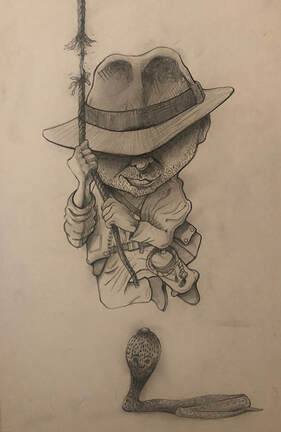|
For this assignment Indy is sketched traditionally with pencil on facing paper and then transferring, using graphite transfer paper, to the watercolor paper. The tracing paper allows for more sketching, mistakes, problem solving, without making the final look too muddy are have a ton of eraser marks. From this point most problems are fixed and ready for color.
|
When starting color on Indy, I used a few varieties of earth tones and very little cool colors, even on the snake. I used a High Flow acrylic Burnt Sienna paint/ink from Golden and allied with an airbrush to seal in the pencil. Another way of achieving this would be to soak the paper in water and stretch the watercolor paper on a board and applied a waterbed medium to the picture. The water also seals in the drawing and gets rid of the powdered graphite while the drawing and pencil becomes part of the paper. Finally, an old toothbrush is load up with some Burnt Sienna and I run my thumb over the bristles to apply the splattering paint. Always one of the more fun parts of the process. It also gives a nice messy look to the picture.
|
Watercolor and ink washes are applied to the final steps. An old hair dryer is used to speed up the process between drying times. Once the paint is finished, dried, and sealed I will use either a spray fixative or a wash of Liquitex Ultra Matte Medium before applying colored pencil to the illustration. I mostly used Prismacolor and Col-Erase for the subtleties. Depends on what the painting needs at the time. Each artwork in unique unto itself and each one calls for a different approach. Indy is a lot of earth tones, shades of brown, and dirty. Someone else may be the exact opposite. Thanks for looking.
|


